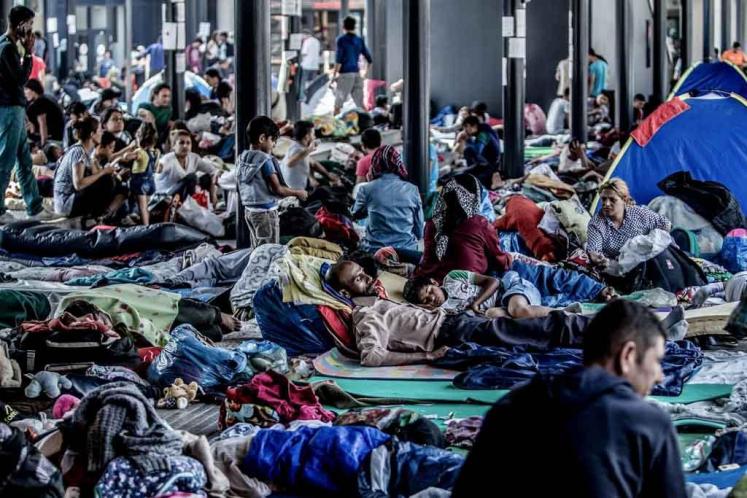The conditionality of global compassion has been made clear again in recent days. In the early hours of 14 June, a fishing vessel carrying asylum seekers and migrants sank off the coast of Greece after multiple distress calls. There was a limited international response – despite it being one of the biggest tragedies in the Mediterranean in recent years.
In contrast, the search for the missing submersible, which visited the wreck of the Titanic, involved US, Canadian, French and UK vessels and multiple rescue organizations. These events lay bare the different levels of concern afforded to those in contrasting circumstances and from different backgrounds – with race, country of origin, and class playing a role in who is seen to be worthy of receiving compassion.
These incidents coincided with World Refugee Day and the start of Refugee Week in the UK. The theme this year was compassion, and what compassion looks like in practice. A compassionate approach to asylum policy and practice has the potential to both recognize suffering and promote action to reduce this suffering in meaningful ways.
Currently, asylum policies are becoming increasingly restrictive and moving away from the international norms of non-refoulement and access to safe territory, particularly in countries in the Global North. In this context, moving from a rhetoric of compassion to acting in compassionate ways could sustain and strengthen the global asylum system and move towards a world where asylum seekers and refugees have secure rights.
In this blog, I outline three reasons why taking a compassionate approach to asylum policy may need to be considered, and what can be gained from this.
History has shown us that compassion promotes wellbeing and helps avoid tragedy
The 1951 Convention Relating to the Status of Refugees (the Refugee Convention) was a historical global effort to place compassion at the heart of our legal systems and policies regarding asylum. The Convention was developed in response to a large increase in the number of individuals forcibly displaced during and after the Second World War, building on work which began as a result of forced displacement after the First World War.
Since the Refugee Convention was both time- and geography-specific – confined to those displaced by events before 1951, with States able to further restrict it to events within Europe – the subsequent 1967 Protocol relating to the Status of Refugees (the Protocol) was introduced to remove these restrictions, providing protection to all refugees covered by the definition within the Refugee Convention.
Moreover, Article 31 of the Vienna Convention on the Law of the Treaties requires that treaties, such as the Refugee Convention, are interpreted “in good faith in accordance with the ordinary meaning to be given to the terms of the treaty in their context and in light of its object and purpose.” In other words, the Refugee Convention should be understood in line with the “generous spirit” and intentions of the Convention, namely the protection of refugees, rather than through a literal and/or restrictive interpretation. Adopting a compassionate approach is therefore a requirement at the heart of the Refugee Convention, emphasizing that States should be working towards this concept in their treatment of refugees and asylum seekers.
Compassion allows for a departure from linear thinking and speaks to the complexity of asylum seeking
Compassion is important because the act of seeking asylum is complex and can be best understood when there is a willingness to understand that complexity. Ongoing research on the complexity of asylum seeker decision making, led by NatCen International, in collaboration with the University of Westminster and several migration experts, has pointed out that there are a number of factors, some of them unknowable, that affect the choice of country in which an individual claims asylum. These included factors such as personal agency, imagined experiences in different destinations, cognitive and/or emotional readiness to begin the journey, as well as macro-level factors, including conflicts or other difficulties in countries of origin prompting movement, asylum policies, and border management methods.
Compassionate asylum policies need to take account of the highly complex and often very stressful and dangerous journeys asylum seekers have had to make to find safety.
Compassionate policies work
There are examples of successful ‘compassionate’ policies from countries in the Global North. One recent example comes from the UK. The Homes for Ukraine scheme (formerly the Ukraine Sponsorship Scheme) was introduced in March 2022 in response to the Russian invasion of Ukraine in February 2022. Over 163,400 visas have been issued through this scheme.
There have been a number of important and valid concerns about the scheme, particularly around higher rates of homelessness due to the rising cost of living, the level of support for hosts, and difficulties finding private accommodation. However, it provides a clear reminder that compassionate policies which respond to global events in a timely manner are able to provide those fleeing with necessary protection, and that the public will take action to provide support to those in need when given the opportunity.
Importantly, it shows that safe and legal routes, when they exist, can be effective and help those fleeing avoid dangerous, irregular pathways. In order to create a functional, and compassionate asylum system, similar routes could be universally available to those who have been forcibly displaced from both European and non-European countries.
However, fewer than 1 per cent of UNHCR-recognised refugees are currently processed for resettlement each year – due to high demand and limited places available. A tendency to provide safe and legal routes only to certain nationalities, and not others, also implies that some asylum seekers are more “deserving” than others, perpetuating racialized and gendered narratives regarding which people are “genuine” asylum seekers. This practice further undermines the international asylum system as a whole; all those fleeing and in need of protection should be able to access the system without having to make dangerous journeys.
It is also essential to end the fearmongering regarding refugees and asylum seekers by politicians as it distorts the obligations that countries have under international laws and agreements, legitimizes a lack of safe routes, and contributes to a hostile environment when asylum seekers and refugees arrive in their destination country.
There is much uncertainty as to what the future of migration and asylum will look like, particularly regarding how asylum processes are managed and shared between States. The only thing that is certain is that whatever the international asylum system looks like going forwards, compassion should be at its heart.
The views expressed in this blog do not necessarily reflect the views of the National Centre for Social Research, NatCen International, or UNU-CPR.
Suggested citation: Felicity Kersting., "Why Compassion Matters in Asylum Policy," UNU-CPR (blog), 2023-06-28, 2023, https://unu.edu/cpr/blog-post/why-compassion-matters-asylum-policy.




